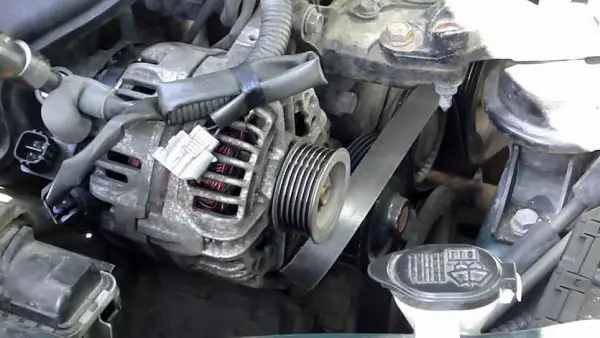You need to repair or even replace your alternator when you find some odds things in your car. You will find the car lights are dim, and the heater doesn’t work well, sometimes the car is even difficult to start.
In short: How much will it cost me to repair the alternator?
First, you have to note that some alternators are beyond repair, and the only thing you can do is replace them. Therefore, for alternator replacement, you will need to pay a rough price range of $500 to $1000.
Suppose your alternator is slightly damaged and thus requires only a few repairs. In that case, you are lucky since you will have to part ways with approximately $100 to $150 that covers all the costs, including the analysis fee.
Before revealing to you how to repair an alternator, it would be best to explore the basic functioning of an alternator.
Understanding how an alternator operates is key to identifying a malfunctioning alternator’s most general and regular indications.

In the next topic, I will inform you more about knowing these signs and ways of handling them on your own. After properly comprehending these concepts, I will go straight to the specifics of the costs of repairing your alternator.
Table of Contents
How Alternator Works
Did you know that your car battery’s primary function is to ignite the engine correctly when you turn the ignition key? Many people think that it is the battery that keeps the car going.
Well, the battery plays a significant role, but the reality is that immediately after starting your vehicle, the alternator takes charge.
When a car is moving, the power generated in the vehicle is due to the alternator converting mechanical energy to electrical energy. The alternator gets the mechanical energy from the engine when the car is in motion.
The alternator supplies this electrical energy to all the electrical components in the vehicle, including but not limited to the radio, AC, automatic windows, power steering, dashboard signals, front and rear lights.
Allow me to introduce you to the main components of an ideal alternator;
Stator and rotor
Take a closer look at the alternator. What do you see? You will notice that a belt connects your car’s crankshaft to the rotor.
When the vehicle is in motion, the crankshaft usually rotates, and subsequently, the rotor also rotates. This subsequent rotor rotation leads to creating a magnetic field around the stator, thus converting the energy in motion to electrical power.
Diode
The diode sometimes goes by the rectifier, whose primary function is to convert the alternating current from the stator to the direct current.
Regulator
A regulator’s primary function is regulating the amount of current that the alternator produces. Therefore, with a perfectly functioning regulator, your car’s alternator will neither have less electric energy nor will it produce excess electric energy.
Therefore, it is essential to note that these three key components depend on each other for effective functioning. That means that when one of the above components fails to work, the different components will not work.
Therefore, since the battery receives electric energy from the alternator, the vehicle will have issues starting the engine and powering the whole electrical system.
Symptoms of Bad Alternator
The following are warning signs of a malfunctioning alternator;
When the Engine is Not Starting as it Should
Remember earlier when I talk about the primary function of the battery in your car? Your car’s battery is responsible for starting the engine.
After the engine has started, the alternator takes charge and keeps the car going.
But how does it achieve this? That’s where the alternator comes in. The alternator continuously supplies the battery with the adequate electric energy needed to keep the vehicle in motion. Without the alternator, the battery would drain off quickly, and the car would stop moving.
Faulty Electrical Components Within the Car
When there is a breakdown of the alternator, you will quickly diagnose the issue by observing how the various electrical components in the car are working.
For instance, the power windows might have difficulty moving up and down. Also, the dashboard lights, headlights, and rear lights might begin turning dim, indicating that they are not receiving enough current.
The early you identify these warning signs, the better since it means that the alternator will not have a complete breakdown, thus avoiding unnecessary costs.
Weird or Unusual Sounds
Mainly the alternator produces unusual sounds due to wearing out of the belt that connects the alternator and the crankshaft. The belt might even be out of the line where it should be. Also, there are possibilities of worn-out bearings in the rotation sections of the alternator.
A Battery Shape Indicator Pops-up
This is one of the easiest ways to respond to a faulty alternator. However, the battery shape lighting indicates the malfunctioning of the whole charging system.
Since the alternator is part of the charging system, it is up to you to determine whether the issue arises from the alternator or the battery itself.
How to Tell if Alternator is Working Properly
Running tests on the alternator requires the help of some essential equipment like the multimeter. The multimeter will help determine the current, resistance, and voltage around the charging system. This equipment is affordable as you can get it at your nearest store for approximately $15 to $100, depending on the features.
Battery Testing
As you may notice, your multimeter has a unique design consisting of two extended probes with distinct colors, black and red.
So, to perform a quick check on your car’s battery, you need to make sure you have connected each probe to each terminal on the battery. Be careful as the red probe should go to the positive terminal, whereas the black probe should attach to the negative terminal.
Observe the readings at the display of the multimeter. The standard readings should range from 12.2V to 12.6V. Anything below that or above that means that the battery is faulty.
However, you can continue to do a confirmatory test if the reading is below 12.2V. Disengage the battery from the car and find an external charger to charge the battery.
Repeat testing the battery voltage after it is fully charged and stays idle for approximately 12hours. Therefore, you can declare the battery faulty if it still insists on lower readings than 12.2V on the multimeter.
Alternator Testing
When testing for the working of the alternator, it is essential to note that you have to start the engine first. The reason is that the alternator only functions when the engine is running.
Repeat the procedure above on the battery, and if you get readings that are not within the range of 13.8V and 14.4V, the alternator is defective.
It is now time to get to the specifics of how much you need to replace the alternator and alternator repair.
How Much Does Alternator Repair and Replacement Cost?
Once you realize that your alternator is not working, chances are your professional mechanic will have three options for you. The first and the second options involve the replacement of the alternator if the damage is beyond repair.
However, you can replace the alternator with a new one, a renovated one, or a used alternator. In this case, buying a new alternator is better than a reconditioned or used one since it will last longer than the other two.
If you choose to buy a new alternator, or a renovated one, it should have a warranty. However, you should avoid buying used alternators since they have a high probability of breaking down at any time.
How much will it cost to replace an alternator? First, there are flat rates charged hourly, and then there is the cost of either buying a new, renovated, or used alternator. In minor repairs, the additional cost is buying new spares like the belt or bearings.
Additionally, the professional mechanics will charge you another fee for diagnosing the charging system to point out where the problem is originating mainly. This fee ranges from $80 to $120 or even more depending on the dealers. In most garages and dealers, the hourly rate ranges from $50 to $100.
Since the maximum time that a professional mechanic can replace an alternator is 2 hours, it will cost you approximately $300 to a maximum of $500. Combining the diagnosis, hourly, and alternator price tag adds up to around $480 to a maximum of $940 to completely replace the alternator.
In case your alternator needs repairs, the cost will be much less than replacing the whole alternator.
Conclusion
Remember that regular service checking the alternator and executing alternator repair where necessary is vital in saving you from replacing the whole alternator.
Since you are now aware of the rough estimates of alternator repair and replacement, you will not find yourself in a situation where shops and dealers charge you excess money.




